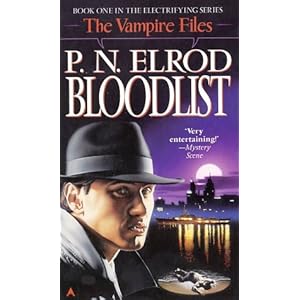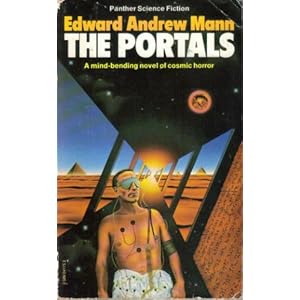Saturday, February 4, 2012
TIME CAPSULES classic book reviews by Bill Lindblad
BLOODLIST (1990) by P.N. Elrod
Horror, like every other genre, has boundaries. What constitutes those
boundaries is always a source of debate with the terms of the debate
changing in accordance with both literary trends and general society.
Bloodlist was not marketed as horror. It was marketed as science fiction,
which it is assuredly not: the book is the first in what became a successful
mystery series set in mob-era Chicago. What distinguishes it from other
historical mysteries is the lead character, a former reporter named Jack
Fleming who is undead. The series is known as The Vampire Files, and it is
an indication of how ahead of the current trends P.N. Elrod was that she was able to develop that title. There are at least a dozen vampire mystery
series either with a vampire or a Buffy-esque fated slayer as the
protagonist. Pat was simply at the game earlier than the others.
Is it horror? I don't think so, but with a vampire as the main character it
is often shelved there. It's not even particularly dark for dark fantasy;
it's closer to a crossover fantasy / mystery novel with the fantastic
element being the existence of vampires. That's not to say there aren't
horror scenes within the series. There are, because gangland Chicago gave
rise to some very violent, conscienceless people. I can understand the
argument that has resulted in this book and the others in the series
sometimes being shelved (where such bookstore distinctions remain) as
horror.
I enjoy when the borders of horror are pushed. It results in a genre with
greater depth and breadth. My only requirement is that any book that tries
to expand the boundaries does so well.
This book does it well. Elrod plays fair with the reader, using all of the
classical vampire traits for her protagonist and working within the
conventions of the 1940s pulp-style mystery novel. Perhaps more impressive
is the fact that this was the author's first novel, and one of her first
professional sales.
The reader gets to follow Fleming as he attempts to discover who had him
killed and why, while at the same time attempting to learn the ropes of
being a vampire. The main character is given solidity through a combination
of his interactions with others and some flashback sequences of key points
in his life. Interesting secondary characters are introduced and allowed
their own development. Loose ends are provided as starter threads for
future books, but none need completion for a satisfactory conclusion to the
novel. And like so many sf, fantasy, and horror books, all of this is
packaged with a cover that bears no resemblance to any scene within the
story.
It's a standout book that did what the author intended, and if it can be
criticized for not transcending the genres it straddled, it should be
commended for the job done satisfying the requirements of those genres.
Four stars out of five.
THE PORTALS by Edward Andrew Mann
This is another book which was marketed as science fiction, and with a far
more sf cover than Bloodlist. While the former had a physically altered
vampire on the cover, the paperback edition of The Portals shows a man in an Altered States-style set of electrodes connected to his body while around him can be seen both stars and the Pyramids. The potential reader might not even realize there was a horror element in the book unless they read the tagline: A mind-bending novel of cosmic horror. And the potential reader would then likely wonder what the cover art had to do with horror.
I'm still wondering that myself.
The book reads more like a pair of connected novellas and a short story than a cohesive novel. That's because the story begins in a format that could have been lifted from any one of a dozen Lovecraftean imitators: a collector wins a book at auction that is written in an ancient language. It is learned that the previous owner died under mysterious circumstances. Well, it's the circumstances aren't really that mysterious... he was rent apart and his head went missing. The questions are who did it and how it was done. But Cary Ralston isn't overly concerned with that; he's simply
wondering what the odd book is. Before you can say Necronomicon,
dismembered bodies lacking heads start appearing in lieu of once-living
associates of Ralston.
If the book had continued along this line it might have been a wonderfully
fun novel, especially in the mid-1970s when Lovecraftean novels were rare
beasts. Instead, halfway through it shifts into another style where the
author moves toward ESP and other psychometric effects as the motive device
for the story. Then, in the final ten pages, the book makes a sharp veer
in the direction of new age mysticism as it neatly ties up the story. Note
that I said "neatly", not "believably".
The result is a muddled work that allows the author to demonstrate some
skillful tricks but ultimately fails due to leaning far too heavily first on Lovecraft and then on Altered States.
Two stars out of five.
NIGHTMARE by Anne Blaisdell
While most readers have never heard of Anne Blaisdell, if they were mystery
readers they are probably familiar with two other pseudonyms the author
used: Lesley Egan and Dell Shannon. All were fictitious names for Barbara
"Elizabeth" Linington, who was one of the earliest and most successful
female writers of the police procedural subgenre of mystery fiction. In
Nightmare, she chose to bypass her standard fare and instead created a story of an innocent prisoner attempting to outwit her captor.
The basic story is truly simple. The book clocks in at under 200 pages, and
that's despite many paragraphs being devoted to either extensive analyses of the rationale behind a character's actions or minutiae associated with the room in which the prisoner finds herself.
The book was nominated for the Edgar award for best novel, and that was not
an accident. From a mystery standpoint, it was a great thriller when it was
released in 1961. While there are no chase sequences or multi-twist plots
that are the hallmarks of the contemporary thriller, there is a completely
rational premise that could easily play out in life and readers are treated
to watch as the sympathetic protagonist steadily moves toward one of only
two possible fates: death or rescue.
The book was turned into a movie starring Stephanie Powers, Die! Die! My
Darling, that managed to further elevate the book by sticking to the
original material's events and diaglogue while introducing the acting of
Powers and Tallulah Bankhead, the delighted excess of Hammer Films and the
sharp screenwriting of Richard Matheson.
It's hard to rate this book accurately, because in tone and construction it
is a creature from another age. If I were going to approach it purely from
the modern perspective, I'd have to rate it one star down from what I'm
giving it.
Five stars out of five.



